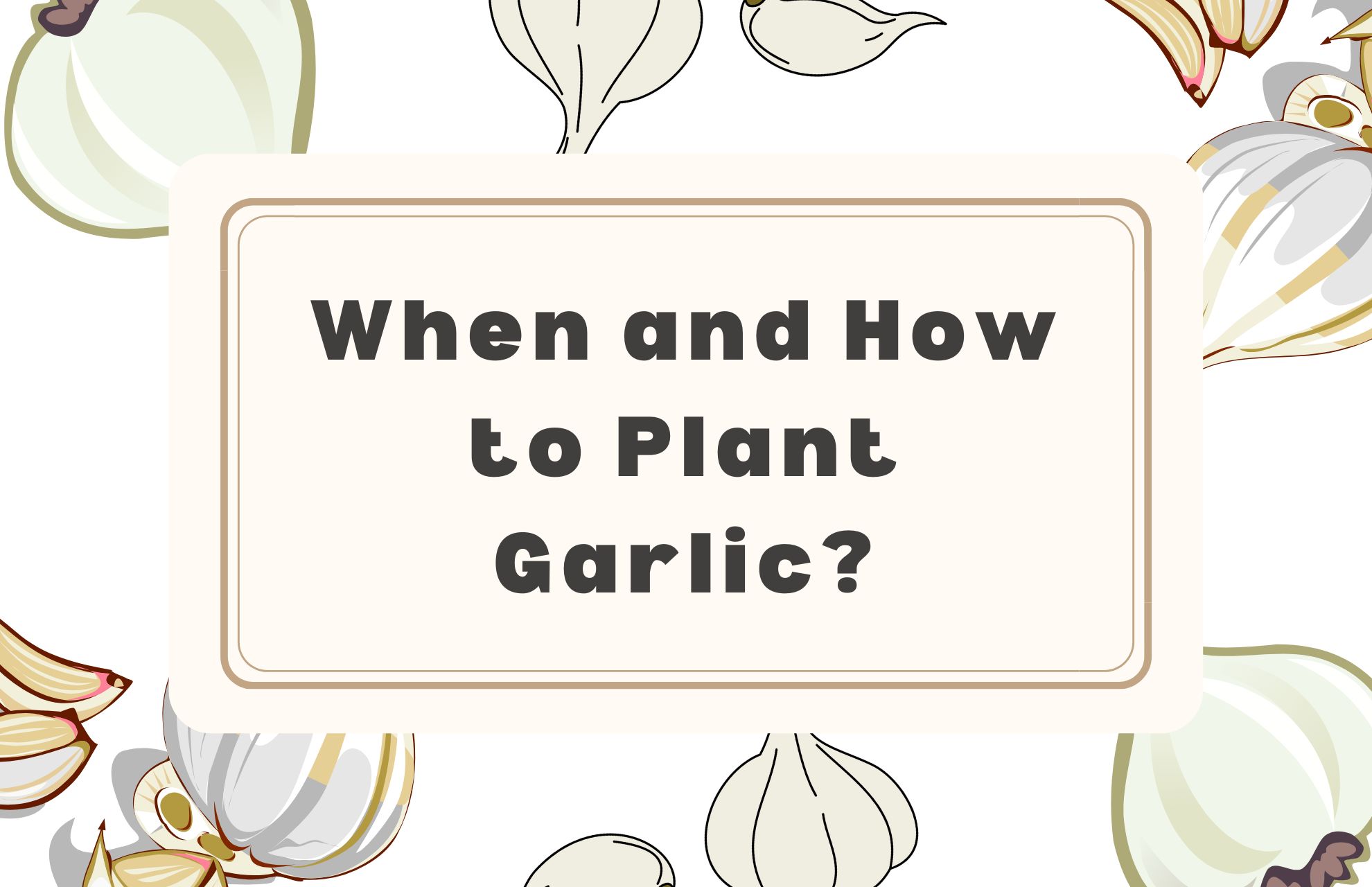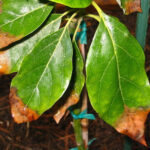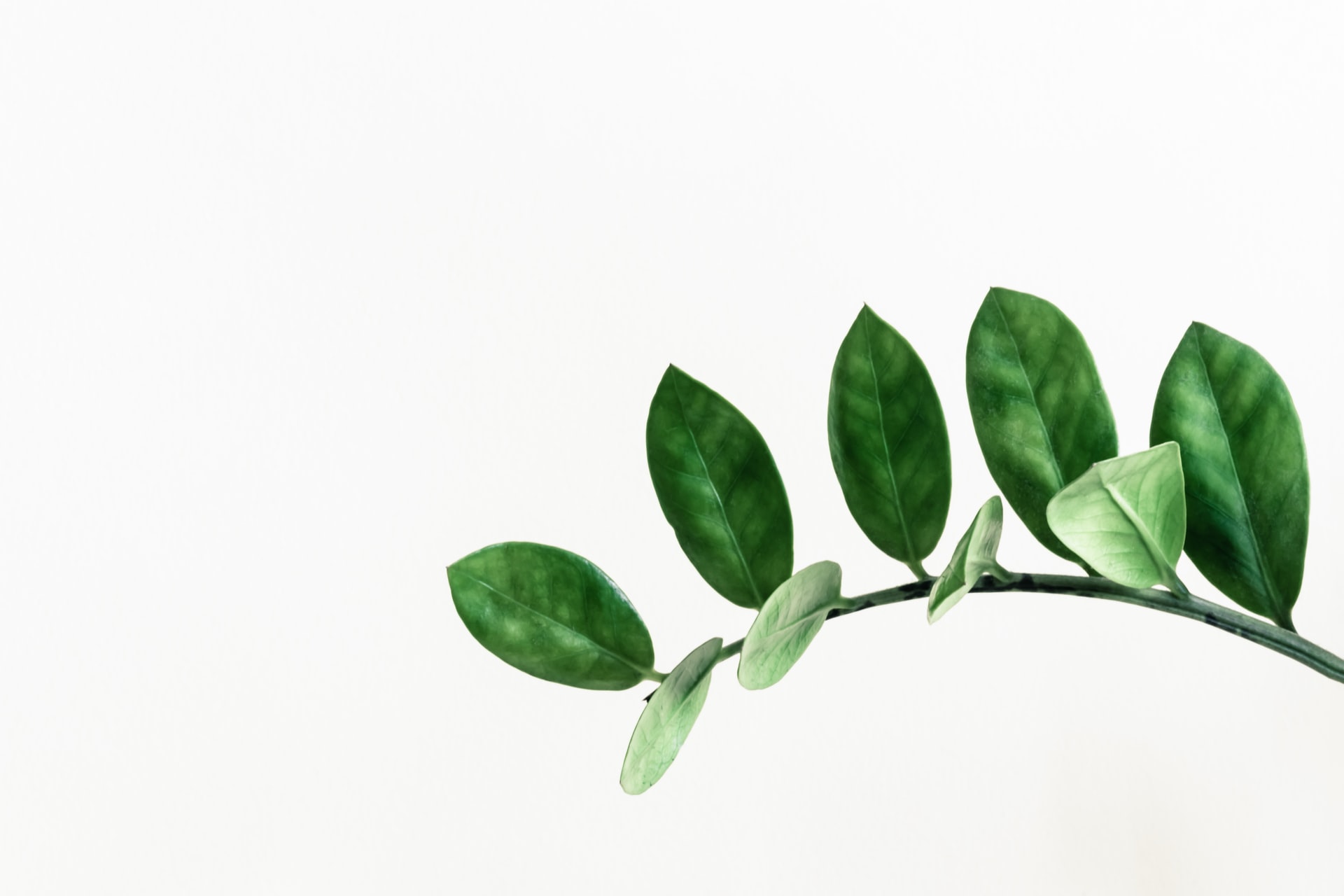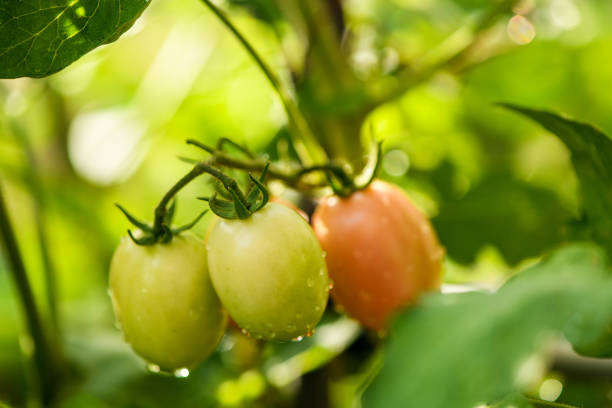Our guide contains all the information you require for growing garlic at home.
An intimidating task may be growing garlic. Although it is not as difficult as growing tomatoes, growing garlic does take some time and persistence. Garlic is a great crop for maintaining your garden’s year-round production because it grows all winter long.
Additionally, heads of garlic can be used in the kitchen and enjoyed for months longer than many other garden vegetables because they can last for a long time when properly stored and cured.
You can use your own homegrown garlic to prepare meals from scratch if you have a little patience. To plant, grow, and harvest garlic in your home garden, simply follow these simple instructions.
When to Plant Garlic?
A crop grown during the cool months is garlic. It is typically planted in the fall, following the first minor frost of the year. As long as the ground hasn’t frozen, it can be planted at any time. Garlic is a bulb. Like other spring bulbs, it needs to go through a “chilling” period.
This chilling period stimulates a bio-chemical response that “turns on” flower formation and initiates root growth. For between four and eight weeks, garlic needs to be chilled to at least 40 degrees Fahrenheit.
Garlic can be planted in the early spring in regions with long growing seasons. Although the cloves won’t grow as big, you can still eat green garlic or garlic scapes.

Where to Plant Garlic?
Rich, draining soil is ideal for growing garlic. It requires six to eight hours per day of direct sunlight. Consider this when choosing a location for your garlic because the angle of the sun varies throughout the year.
From winter to spring, the site should ideally remain in full sunlight.
Pick the Right Varieties
Garlic cultivars won’t all thrive in all environments. Garlic can be divided into two major groups: hardneck and softneck.
- Hardneck garlic has stiff stalks and is better suited to colder climates. They produce edible scapes, a flowering stem. Hardneck garlic yields fewer cloves per head than softneck garlic and does not keep as well in storage as softneck garlic.
- Softneck garlic has more flexible stems and is better suited for southern climates. In colder climates, softneck cultivars can also be grown. When stored correctly, softneck garlic keeps very well. However, although you can braid the stems together for hanging, softneck does not produce scapes.
How to Plant Garlic?
Due to the need for a period of cold weather for the cloves to develop into bulbs, it is best to plant most varieties of garlic in late autumn or early winter.
Make sure your soil is free of weeds and summer crop residue. Before planting, rake over the area well and add some homemade compost or well-rotted manure. In order to leave 30 cm between rows, dibber or push cloves into the ground 15 cm apart.
Lay bird netting or horticultural fleece over young plants until the shoots are 5 cm tall to prevent birds from digging up the bulbs out of the ground. You might need to use cloches to protect plants over the winter in colder climates.

In order to prepare plants for spring growth, this additional protection will promote root development.
- Just before planting, work a few tablespoons of 5-10-10 complete fertilizer, bonemeal, or fish meal into the soil a few inches below where the base of the garlic cloves will rest.
- Choose cloves that are large, healthy, and free of disease. The bulb you will get the following summer will be bigger and healthier the larger the clove.
- A few days prior to planting, separate the bulb’s cloves while retaining the papery husk on each individual clove.
- Cloves should be planted upright, 4 to 8 inches apart, and 2 inches deep (with the pointed end facing up and the wider root side facing down).
- Rows should be 6 to 12 inches apart when planting. Depending on the variety, a single 10-foot row ought to produce around 5 pounds of the fragrant bulbs.
How to Care for Garlic?
Little maintenance is necessary for garlic. When the foliage starts to turn yellow in the spring and the early summer, it’s time to cut back on the watering because that means the bulbs are getting ready to bloom. To lessen competition for nutrients and water, weed between the plants.
The best way to do this is by hand because hoeing could harm the developing bulbs. You can use the flowers or “scapes” that the plants produce in stir-fries, so remove them.
- To ensure proper overwintering, gardeners in regions where the ground freezes should heavily mulch garlic beds with straw or leaves. For more information, see our mulching guide!
- When the risk of frost has passed in the spring, mulch should be removed. (Young shoots can’t independently survive in temperatures below 20°F/-6°C. Do not expose them.)
- As the weather begins to warm up in the spring, shoots will start to appear through the ground.
- Flower shoots that appear in the spring should be removed. This could result in a smaller bulb.
- The heavy eater garlic. Early in the spring, side-dress or broadcast with blood meal, pelleted chicken manure, or a synthetic source of nitrogen like a pelleted fertilizer.
- Just before the bulbs start to swell in response to extending daylight (typically early May in most regions), fertilize once more. If the leaves start to turn yellow, repeat.
- Ensure the planting area is kept weed-free. Competition is bad for garlic; it needs every nutrient that is available!
- During bulbing (mid-May through June), water once every three to five days. Irrigate every eight to ten days to a depth of two feet if May and June are particularly dry. Stop watering gradually as mid-June draws near.
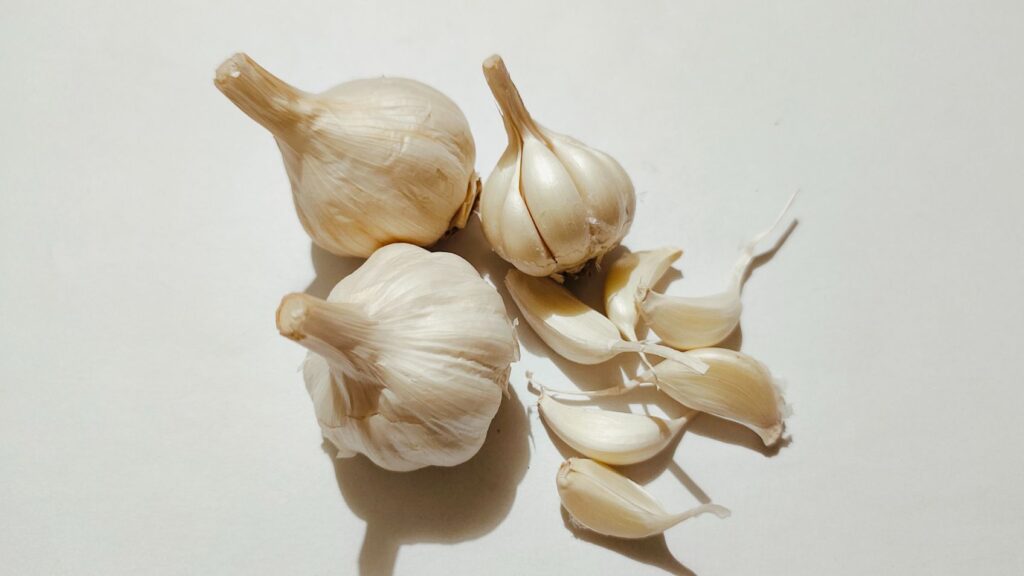
Growing Garlic: Problem-solving
Garlic only occasionally experiences pest problems and is generally pest-free.
Birds
Birds, particularly pigeons, will eat newly germination plants as well as freshly sown garlic cloves that have been taken from the ground. After sowing, immediately cover the area with netting or horticultural fleece, and don’t remove it until the young plants are at least 5 cm tall.
Onion White Rot
The first sign of anything amiss is typically yellowing, wilting foliage, but this usually occurs around harvest time, when you’d expect the leaves to be dying back anyhow. Onion white rot is difficult to detect until it’s too late.
When you dig up the plant, you’ll find a white, fluffy fungus and small, black growths at the base of the bulb. The bulb will be black and rotten in severe cases.
The disease onion white rot is soil-borne, so there is no cure and it can last for many years. The disease can affect all members of the allium family, including onions and leeks, so try to avoid spreading it with your boots and gardening tools.
Dig up all of the harmed plants and discard them or burn them; do not add them to the compost pile. While you might be able to save some of your harvests for consumption, it won’t keep well. In the future, grow garlic in pots with new soil that is not from the garden.
Leek Rust
Leek rust, a fungal infection that occurs more frequently in moist weather, can harm garlic. There is no treatment; in the summer, orange pustules develop on the leaves, which then start to wither away.
The affected plants should be immediately harvested to stop the spread of the disease and eaten right away, even though the bulbs are perfectly safe to eat.
The remaining plant matter should be disposed of (in the trash or burned; do not add it to the compost pile) and garlic, leeks, and onions should not be grown in the same spot for three years. To reduce humidity, space plants apart and choose a variety that has some rust resistance.
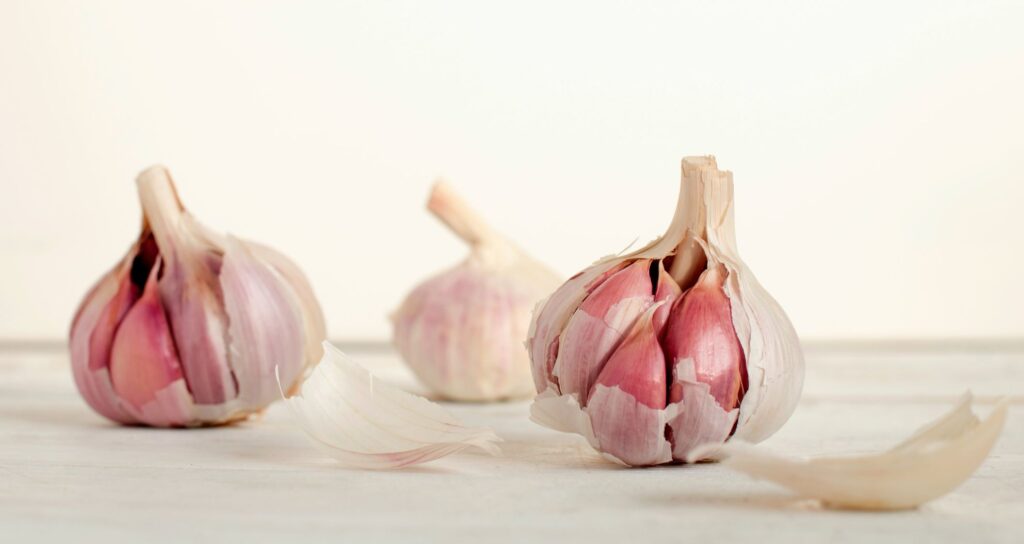
When and How to Harvest Garlic?
Garlic that was planted in the fall might be ready to be pulled up as early as May or June in Southern climates. In the North, the harvest may begin as late as mid-August or as early as the middle of July.
The leaves that climb the stalk of the garlic plant change color from green to yellow and then brown as the plant reaches maturity. The leaves start to lose their strength and flop over. Your garlic is maturing, and this is a good sign.
According to conventional wisdom, the garlic is ready when the first four leaves, starting from the bottom, have turned brown. This is roughly one-third of the height of the stalk. When at least half of your garlic plants reach this stage, stop watering for a week and then test it by pulling up one bulb.
It could harm the plant to forcefully pull the bulbs out of the soil. Use a trowel or garden fork to gradually loosen the soil around the garlic before attempting to pull it up. The bulb ought to then easily emerge from the ground.
Water the remaining garlic, give the bulbs another week to grow and then repeat the test if the first bulb is much smaller than the variety was predicted to grow to. Keep in mind that the size of the bulbs produced by the largest cloves will always outweigh those produced by the smallest cloves.
If garlic bulbs are left in the ground for an excessive amount of time, the protective skin may start to separate and crack.
Keep the stalk and roots of garlic after it emerges from the ground. Garlic must first be cured for storage if it wants to last long.
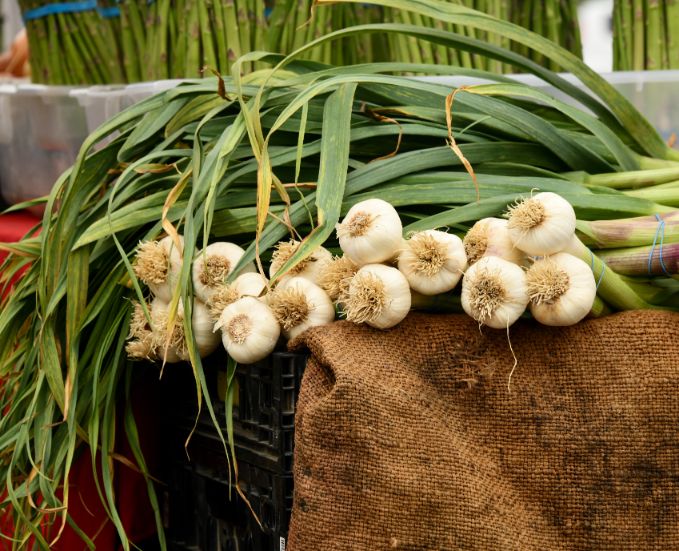
How to Cure and Store Garlic?
Garlic needs to cure before it can be used, but it can be used right away if you want to use it right away. For two weeks, leave them in a dry, shady area with good ventilation. You can spread them out on a wire rack or hang them upside down on a string in groups.
After curing, the husks on the bulbs should be papery and dry. The bulbs should be kept in a cool, dry area with lots of ventilation. As it dries, the flavors will progressively intensify. Garlic should keep for six months to a year in a cool, dry place when properly stored.
Conclusion: Grow Your Own Garlic!
In order for garlic to grow well, it needs a long growing season. Autumn through early winter is the ideal time to sow garlic so that plants can develop roots and shoots before the harsh frosts. Some cultivars can be sown in the spring.
Garlic that you grow yourself is always exciting. This spicy bulb gives countless recipes flavor and is so healthy!
FAQs
Can You Plant Garlic Anytime of the Year?
Garlic should be planted from individual cloves in the colder months of the year, from October to February, according to conventional gardening wisdom.
How Long Does It Take for Garlic to Grow?
On average, you’ll be waiting about nine months for seeds to harvest. The good news is that after planting these bulbs, there’s not much left to do but wait. To plant, grow, and harvest garlic in your backyard garden, simply follow these simple instructions.

